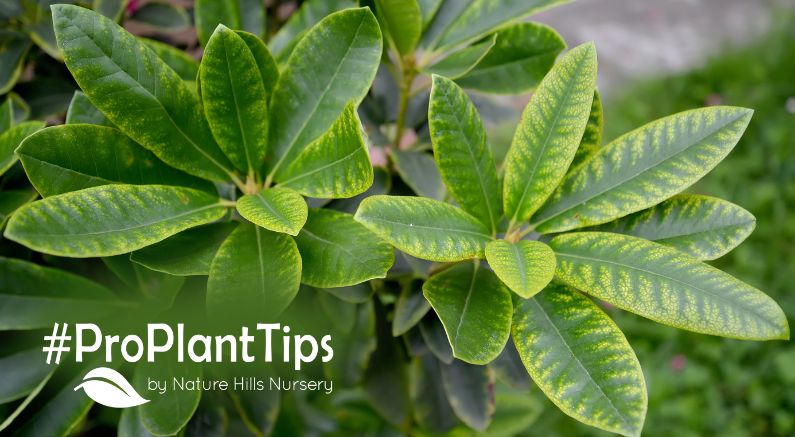Few things make gardeners worry more than seeing beloved Rhododendron or Azalea leaves turning yellow. These flowering bushes are part of the Rhododendron genus, yet they differ in growth habit: most Rhododendrons are evergreen, keeping their leaves all winter, while many Azaleas are deciduous, shedding foliage in fall.
Because of this, understanding what’s normal leaf drop and what signals stress is key to keeping them healthy and blooming!
Yellow leaves can mean natural seasonal change, nutrient deficiencies, environmental stress, or pests. Knowing the difference helps you take the right steps. The most common reasons Rhododendron and Azalea leaves (both belonging to the Rhododendron family) turn yellow include natural leaf aging, too much sun, improper watering, poor soil drainage, high soil pH, or winter stress. With a few smart adjustments in care, you can restore their deep green foliage and vibrant spring flowers.
- Normal Yellowing vs. Problem Yellowing
- Common Causes of Yellowing Leaves
- Care Tips to Prevent Yellowing
- Evergreen vs. Deciduous Leaf Patterns
Normal Yellowing vs. Problem Yellowing

Telling the difference between natural leaf drop and when to worry can sometimes be difficult:
-
Normal aging: On evergreen Rhododendrons, older interior leaves often turn red-purple or yellow and drop in fall. This is a normal process - only the current season’s leaves remain through winter.
-
Deciduous habit: Most Azaleas lose their foliage completely in fall, often with a colorful display before dropping. In warmer climates, some may hold onto leaves a little longer.
- Stress warning: When new leaves turn yellow, especially with green veins, it often signals chlorosis, caused by high soil pH or iron deficiency.
Common Causes of Yellowing Leaves
-
Improper watering: Both overwatering and underwatering can stress roots. Rhododendrons like consistently moist, well-drained soil. Sitting in soggy ground often leads to root rot and yellow leaves. Try the Finger Test to check soil moisture.
-
Soil pH issues: These acid-loving shrubs prefer a pH of 4.5–6.0. In alkaline soils, they can’t absorb iron properly, leading to interveinal chlorosis (yellow leaves with green veins).
-
Nutrient deficiencies: A lack of nitrogen, magnesium, or iron often shows up as leaf yellowing. Fertilizer for acid-loving plants can correct these issues.
-
Too much sun or heat: Rhododendrons especially prefer dappled shade. Too much direct afternoon sun can scorch and yellow leaves, while pairing them with shade trees provides relief.
-
Winter damage: Drying winter winds and frozen roots cause leaves to curl, brown, or yellow. A winter watering routine, anti-transpirant spray, and wind protection can help.
- Wilting with yellowing: When leaves wilt and yellow at the same time, it often signals root stress - either root rot from poor drainage or severe drought stress. Addressing soil moisture balance is critical.
Care Tips to Prevent Yellowing

-
Mulch generously: Apply a 3–4 inch layer of organic mulch over the root zone to conserve moisture and regulate soil temperature.
-
Water wisely: Keep soil evenly moist, especially in fall. Test by pressing your finger into the soil up to the second knuckle - water if it feels dry. Evergreens and broadleaf evergreens need a good, deep watering before winter sets in.
-
Check soil pH: Use a soil test kit. If too alkaline, amend with elemental sulfur or use an acid-loving plant fertilizer.
-
Fertilize thoughtfully: Feed in early spring and right after flowering with a slow-release fertilizer designed for Rhododendrons and Azaleas.
-
Protect in winter: Use burlap screens in exposed sites and apply an anti-transpirant in late fall.
- Rhododendron Proper Pruning: Always prune right after spring bloom to avoid cutting off flower buds. Renewal pruning of older stems encourages fresh, vigorous growth.
Leaf Lessons From Rhododendrons and Azaleas
Evergreen Rhododendrons are expected to shed older leaves each fall - a natural process that can look alarming if you’re not prepared. Azaleas, on the other hand, typically drop most or all their leaves, though in warm climates they may linger. Knowing which type you have helps you tell the difference between seasonal change and stress.
Both shrubs remain garden favorites for their spectacular blooms, shade tolerance, and role as classic flowering bushes in woodland gardens and foundation plantings. With a little attention to soil, water, and seasonal care, you can enjoy lush green foliage and breathtaking spring flowers year after year.
Happy Planting!


